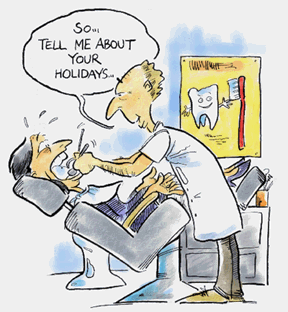Grunt Once for Yes

Think root canal. What a wonderful opportunity to help put my
dentistís kids through college. And also to speculate on the Art
of the One-Way Dialogue.
First my dentist pumped me full of anesthetic. Then he filled
my mouth with all manner of dental hardware. Explaining that the
offending tooth was a tough one to reach, he had me crank my head
around to an angle not designed for human cranking. And then he
told me I was not to move. Keep completely still, he said, and
donít try to say anything.
As he began to work his dental wonders, he did what I believe
is a prerequisite for his profession. He started talking. And
periodically, despite the fact that I was incapable of
articulating a single simple syllable, he asked me questions.
It would have been bad enough if his questions merely required
a yes or no answer. I mean, you try it. Open your mouth as wide
as you can, tilt your head at whatever angle hurts the most, and
then while pretending youíre anesthetized, try saying
"yes." Then "no."
See what I mean? All you can do is grunt. And a yes grunt
sounds much like a no grunt.
Not that he limited himself to yes/no questions. I could swear
he seemed to favor questions that required the use of mís, pís,
fís and bís. But all I could do was give him an answer grunt,
which was indistinguishable from the yes grunt and the no
grunt.
Periodically, he asked me if I had any questions. Yes, I
thought: Why do you keep asking me questions when I canít answer
them? I tried to answer "yes" grunt, but he
misunderstood and thought I said "no" grunt.
In defense of my dentist, I should point out that at the end
of my first visit, he explained in detail what he had done and
what he would do next. His explanation came complete with
pictures that he drew for me. Most were pictures of teeth, but one was a
picture of a nutcracker, which he used to illustrate the
different amounts of pressure needed to chomp down on something,
and how this can result in damage to teeth ó and maybe to
nutcrackers, as well, though he didnít say.
On my second visit ó the one in which we put his second born
through her freshman year ó he again made me grunt-ready and was
quickly off and yakking. Giving him the benefit of the doubt (and
being too cowardly to stifle the mutterings of anyone in mid-root
canal when itís my root thatís being canaled), I told myself he
was just trying to be amiable and help me pass the (not overly
enjoyable) time.
His technique, though, reminded me of sales and service people
who are so busy responding to their customersí needs that they
never stop talking long enough to understand what those needs
are. You know the people I mean: The ones who ask questions and
then ignore the customersí responses. The one who assume they
know the answers before theyíve heard them. The ones who provide
little or no time for their customers to ask them
questions.
And my favorites: the ones who are so eager to solve their
customersí problems that they ignore their customers
altogether.
My dentistís daughter wanted to spend her junior year abroad,
so he invited me back for a third visit. He dosed me with
anesthetic, loaded me up with the usual dental paraphernalia, and
then asked, "So how are you going to spend the
holidays?"
I may someday invite him to one of my customer service classes
as Exhibit A.

